Now I think I might make scones every weekend.
Seriously, these are better than the dense, crumbling scones at Starbucks. I am like a master sconemaker now, although, as always, I was filled with doubt.
I decided to make the peppered scones with pear and goat cheese, because I like scones, I like goat cheese, and I don't actively dislike pears. I also had most of the ingredients on hand, and really only had to pick up the perishables (a pear, whole milk, unsalted butter, goat cheese, and plain yogurt) at Kroger. The only thing I had trouble with was the plain yogurt, which apparently only comes in huge vats. I had no idea what I would do with a half gallon of yogurt, so I ended up getting a cup of vanilla flavor, which seemed plain enough.
The first thing I had to do was cube a stick of butter. I did it as fast as possible, and then put the bowl of cubes back in the refrigerator, because the recipe specified that the butter needed to be as cold as possible. Then I set the oven to preheat, and got to work coring, peeling, and dicing a pear:
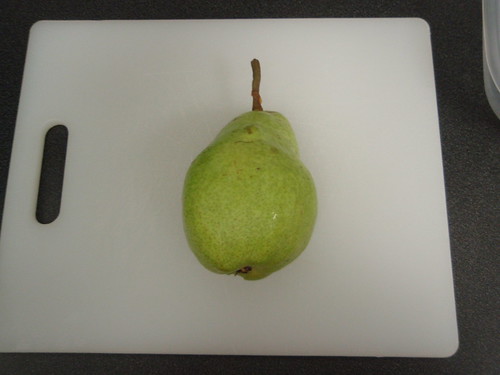
I guess pears aren't in season right now, or people just don't eat them anymore, because those were the only pears they had at Kroger in the regular produce section. There were several varieties of pears in the expensive, organically raised section, but I was already buying a log of goat cheese, and peeling the pear probably takes off most of the pesticide, anyway.
(That opinion is based on my gut feeling, not on actual science.)
While the recipe specified that the butter should be in half inch cubes, it didn't mention what size dice the pear should be. I thought to myself, "How big a chunk of pear do I want to bite into while eating this scone?" and diced accordingly:
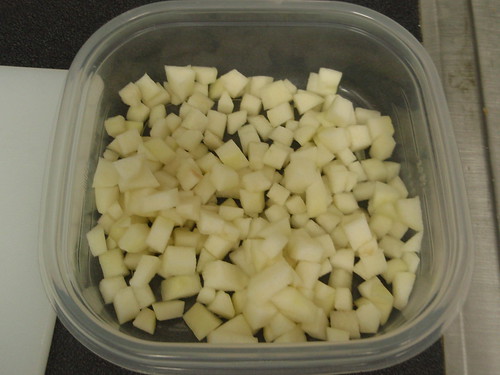
I know. My dicing is not even. I have poor knife skills, but I'm not a professional chef, ok?
After dicing the pear, I cubed the goat cheese into "walnut sized pieces" and then put the cheese and the pear in the refrigerator. The recipe didn't say to do that, but since I was going to mix it all together I had this idea in my head that the butter would stay colder until baking if there were other cold ingredients in the dough.
After that, I mixed the dry ingredients: salt, pepper, sugar, baking powder, and flour. As I could have predicted, I ended up with flour everywhere even though I was trying to be careful:
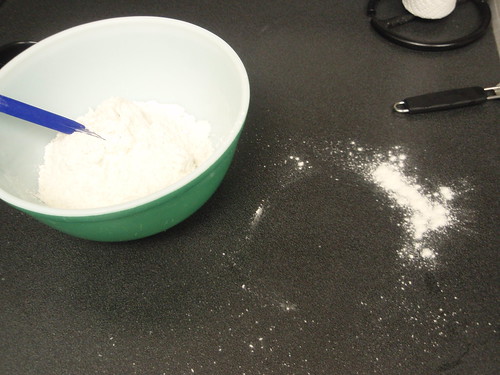
and then I added in the cubes of butter.
Then I was instructed to break up the butter cubes with my hands until the dough crumbled into pea-sized lumps. Wait, with my hands? I don't like getting my hands dirty in the kitchen. Maybe I could fish the butter chunks out, and then cut them into smaller pieces? Or make the dough with a potato masher? Then I remembered some show on the Food Network explaining once that you mix the dough with your hands because the heat of your hands will melt the butter a little, but not all the way, so I stuck my hands in and started crushing butter.
I immediately got butter and flour under my nails, and was disgusted, but I kept working until the dough crumbled:
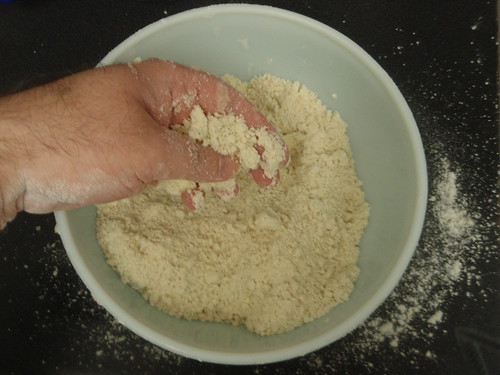
Then I folded in the pear and goat cheese, and then folded in the milk and yogurt:
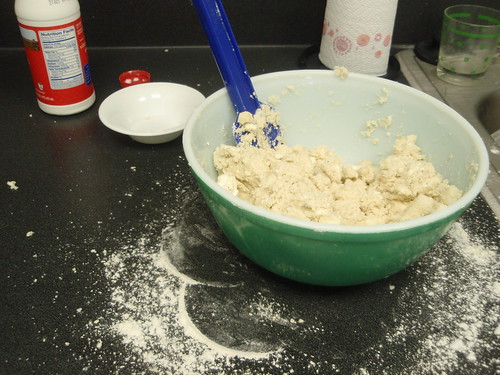
I might as well not even have bothered cleaning up the flour after I mixed the dry ingredients. I even had dough on the camera. Using a serving spoon and my hands, I broke the dough into six pieces, piled them on my baking sheet, and brushed them with milk:
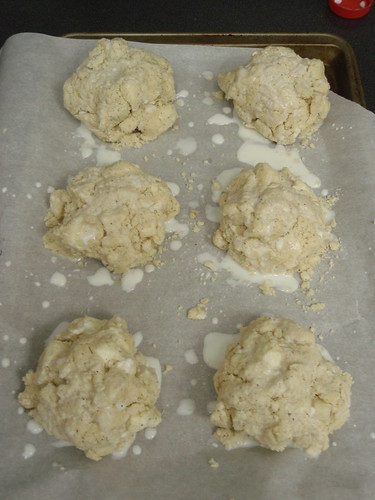
"Brushed" is a subjective term. The milk wouldn't stick to the silicone brush I tried to use, so I ended up more or less slopping some milk on them and hoping for the best.
My hopes appeared rewarded a half hour later (time that I spent cleaning the countertop):
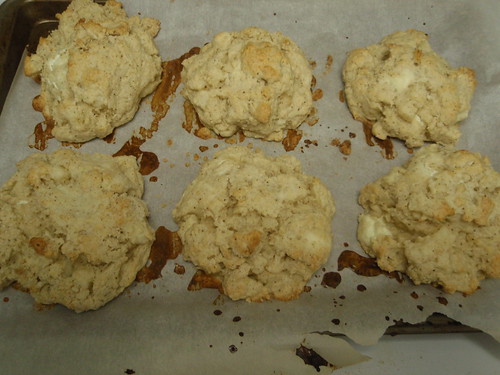
Not only were my scones lightly golden, but they looked shockingly like the scones in the book:

And they are delicious. They're light and fluffy, and there's a little bit of bite from the pepper mixed with a little bit of sweet from the pear. I'm already thinking that I could probably follow the same recipe with a diced apple and cheddar cheese and maybe even some bacon, and I've already eaten three of these for dinner even though it only makes six.
It's ok if I eat them all, because I'll probably be making scones again next weekend.
5 comments:
Joel, you barbarian, buy yourself a pastry cutter.
http://en.wikipedia.org/wiki/Pastry_blender
I had to hunt around because I couldn't remember what these things were called. You use them for cutting in dough, which is the process of blending cold fats like butter with dry ingredients like flour. You mustn't ever use your hands. Aside from being greasy and messy, your hands will melt the fat and spoil the texture of the pastry. A cutter will soften the fat just enough through friction alone.
If you can't find one, use two butter knives, one in each hand. Then cut through the pastry quickly, slicing the blades against each other like scissors.
http://www.blenderexpert.com/pastry-blender.html
*Wallows in grief* Oh, the pastries!
But it said in the book to use my hands!
Also, I had no idea this pastry blender thing existed.
The book was obviously written by communists.
communists who revel in sub-par scones.
But seriously, those look fantastic.
Post a Comment